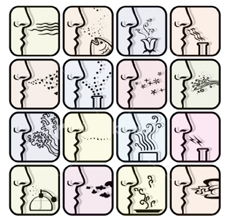Investigating muscle repair, scientists follow their noses
 |
When muscle cells need repair, they use the odor-detecting tools found in the nose to start the process, Emory researchers have discovered.
Found on the surfaces of neurons inside the nose, odorant receptors are molecules that bind and respond to substances wafting through the air. Researchers have shown that one particular odorant receptor gene, MOR23, is turned on in muscle cells undergoing repair.
The finding could lead to new ways to treat muscular dystrophies and muscle wasting diseases and also suggests that odorant receptors may have additional functions in other tissues.
Several years ago, pharmacologist Grace Pavlath observed that MOR23 was turned on when mouse satellite cells—stem cells that renew muscle tissue—were fusing to form extended muscle fibers. At the same time, graduate student Christine Griffin noticed a Japanese report that MOR23 also is turned on in sperm cells and that it influenced their migration.
"Because Christine was writing a mock grant on MOR23 in sperm for a class assignment, we decided it would be fun to explore MOR23's function in muscle," Pavlath says.
The human genome contains around 400 genes encoded as odorant receptors, and mice have more than 900. It is not clear what the MOR23 equivalent is in humans.
The team's results raise a number of intriguing questions about what odorant receptors do in muscle tissue. Pavlath says she wants to identify the molecule in the body that activates MOR23 and investigate what jobs other odorant receptors perform in muscle.
"There is a tremendous variation in humans as far as what odors individuals can recognize," she says. "Could this be linked somehow to differences in the ability to repair muscle?"
 |
Every penny counts...when it comes to funding services at Grady Hospital. This past fiscal year, which ended August 31, 2009, the Emory Medical Care Foundation plowed $28.9 million into Grady to update equipment and support vital services. That amount is on top of the $23.1 million in charity care at Grady by Emory doctors. |
|||


